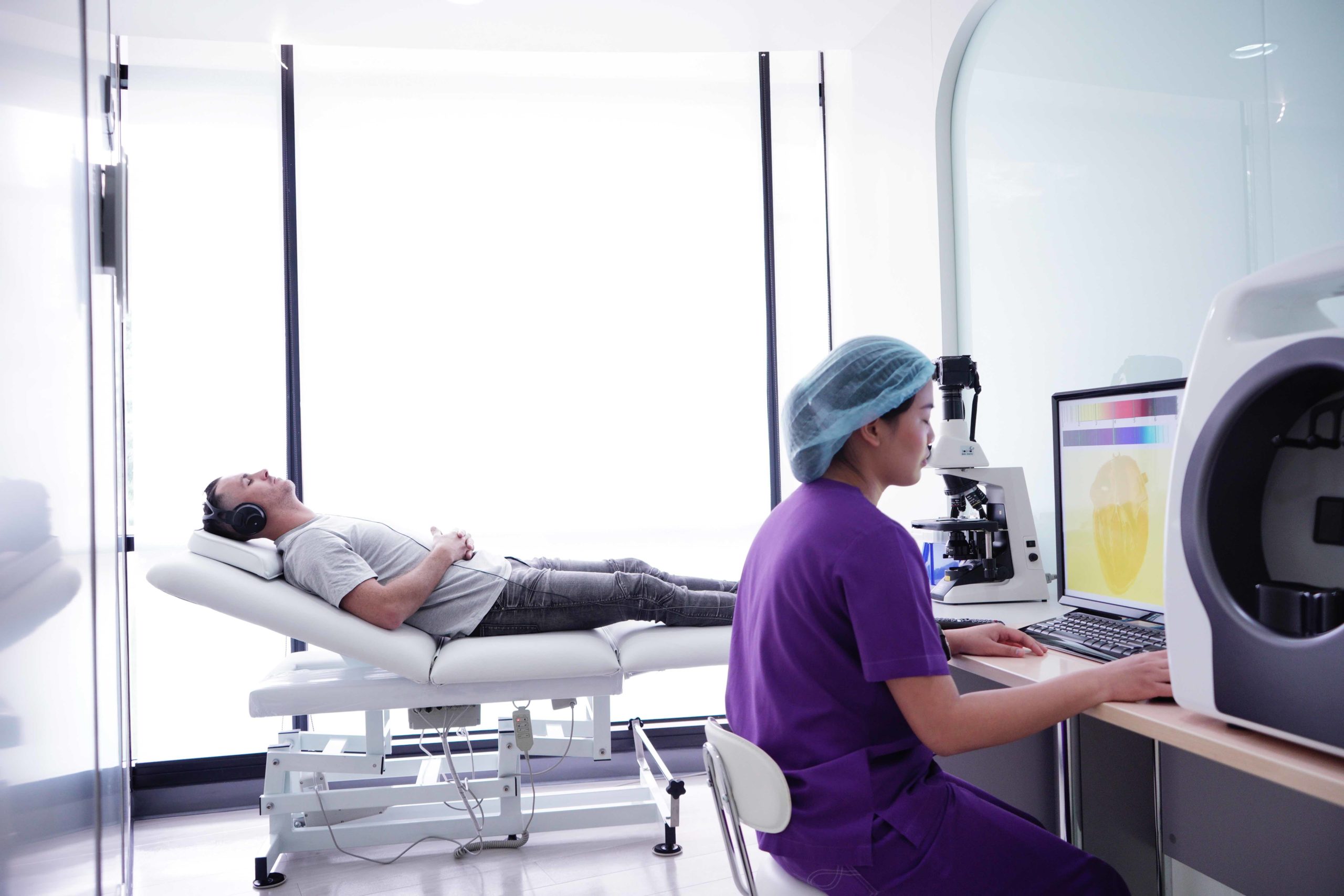Health Screening
SC21 Health Check Up
Providing world-class, doctor-led preventive health assessments and cellular aging profiles to local Thai and international clients for over 12 years in a state-of-the-art, luxury clinic in Central Bangkok.
Our range of health screening assessments and aging profiles have been developed by our medical and scientific experts to provide one of the most advanced bodily and cellular health assessments. We diagnose existing conditions, evaluate key risk factors and develop a preventive strategy specifically tailored to your lifestyle to optimise your health and reduce your rate of aging.



Check Up Packages
- Complete Blood Count (CBC)
- Thyroid Panel: Total T-4; T-3 uptake; Free Thyroxine Index (FTI); T-7; and Thyroid Stimulating Hormone (TSH)
- Lipid Profile: Cholesterol, Total, HDL Cholesterol, LDL Cholesterol, Cholesterol/HDL Ratio, and Triglycerides
- Liver Profile: ALT or SGPT, Albumin,Serum; Albumin/Globulin Ratio; Alkaline Phosphatase; AST or SGOT; Bilirubin, Total; Globulin, Total; LDH; Protein; GGT
- Kidney Panel: Urea Nitrogen (BUN); Creatinine, Serum; Uric Acid; BUN/Creatinine Ratio;
- Minerals and Bone: Iron, Total; Calcium; Phosphorus;
- Fluids & Electrolytes: Chloride, Serum; Potassium; Sodium; Carbon Dioxide
- Diabetes Glucose & HbA1c
- IGF1 Somatomedin-C (SC)
- Testosterone, Total and Free
- Estradiol
- Progesterone
- Estrogens
- Free T4
- Free Tri-iodothyronine (T3)
- FSH & LH
- DHEA, SULFATE
- Human Growth Hormone (HGH)
- Homocysteine
- C-reactive protein (CRP)
- CA-125, CA-15-3, CA-19-9, CEA, AFP
- Vitamin A
- Vitamin B12
- Folic Acid (Folate)
- Vitamin D 25-hydroxy
- Sex Hormone Binding Globulin (SHBG)
- Cortisol
- Urinalysis Complete with Microscopic Examination
Package Price: 34,000 THB ($1,100 USD)
- Complete Blood Count (CBC)
- Thyroid Panel: Total T-4; T-3 uptake; Free Thyroxine Index (FTI); T-7; and Thyroid Stimulating Hormone (TSH)
- Lipid Profile: Cholesterol, Total, HDL Cholesterol, LDL Cholesterol, Cholesterol/HDL Ratio, and Triglycerides
- Liver Profile: ALT or SGPT, Albumin,Serum; Albumin/Globulin Ratio; Alkaline Phosphatase; AST or SGOT; Bilirubin, Total; Globulin, Total; LDH; Protein; GGT
- Kidney Panel: Urea Nitrogen (BUN); Creatinine, Serum; Uric Acid; BUN/Creatinine Ratio;
- Minerals and Bone: Iron, Total; Calcium; Phosphorus;
- Fluids & Electrolytes: Chloride, Serum; Potassium; Sodium; Carbon Dioxide
- Diabetes Glucose & HbA1c
- IGF1 Somatomedin-C (SC)
- Testosterone, Total and Free
- Estradiol
- Progesterone
- DHEA, SULFATE
- Human Growth Hormone (HGH)
- Homocysteine
- C-reactive protein (CRP)
- Vitamin D 25-hydroxy
- Urinalysis Complete with Microscopic Examination
Package Price: 18,500 THB ($595 USD)
- Complete Blood Count (CBC)
- Thyroid Panel: Total T-4; T-3 uptake; Free Thyroxine Index (FTI); T-7; and Thyroid Stimulating Hormone (TSH)
- Lipid Profile: Cholesterol, Total, HDL Cholesterol, LDL Cholesterol, Cholesterol/HDL Ratio, and Triglycerides
- Liver Profile: ALT or SGPT, Albumin,Serum; Albumin/Globulin Ratio; Alkaline Phosphatase; AST or SGOT; Bilirubin, Total; Globulin, Total; LDH; Protein; GGT
- Kidney Panel: Urea Nitrogen (BUN); Creatinine, Serum; Uric Acid; BUN/Creatinine Ratio;
- Minerals and Bone: Iron, Total; Calcium; Phosphorus;
- Fluids & Electrolytes: Chloride, Serum; Potassium; Sodium; Carbon Dioxide
- Diabetes Glucose & HbA1c
- IGF1 Somatomedin-C (SC)
- Testosterone, Total and Free
- Estradiol
- Vitamin D 25-hydroxy
- Urinalysis Complete with Microscopic Examination
Package Price: 14,500 THB ($465 USD)
- Complete Blood Count (CBC)
- Thyroid Panel: Total T-4; T-3 uptake; Free Thyroxine Index (FTI); T-7; and Thyroid Stimulating Hormone (TSH)
- Lipid Profile: Cholesterol, Total, HDL Cholesterol, LDL Cholesterol, Cholesterol/HDL Ratio, and Triglycerides
- Liver Profile: ALT or SGPT, Albumin,Serum; Albumin/Globulin Ratio; Alkaline Phosphatase; AST or SGOT; Bilirubin, Total; Globulin, Total; LDH; Protein; GGT
- Kidney Panel: Urea Nitrogen (BUN); Creatinine, Serum; Uric Acid; BUN/Creatinine Ratio;
- Minerals and Bone: Iron, Total; Calcium; Phosphorus;
- Fluids & Electrolytes: Chloride, Serum; Potassium; Sodium; Carbon Dioxide
- Diabetes Glucose & HbA1c
- IGF1 Somatomedin-C (SC)
- Testosterone, Total and Free
- Estradiol
- Progesterone
- Free T4
- Free Tri-iodothyronine (T3)
- FSH & LH
- DHEA, SULFATE
- Human Growth Hormone (HGH)
- Homocysteine
- C-reactive protein (CRP)
- PSA, CA-19-9, CEA, AFP
- Vitamin A
- Vitamin B12
- Folic Acid (Folate)
- Vitamin D 25-hydroxy
- Sex Hormone Binding Globulin (SHBG)
- Cortisol
- Urinalysis Complete with Microscopic Examination
Package Price: 34,000 THB ($1,100 USD)
- Complete Blood Count (CBC)
- Thyroid Panel: Total T-4; T-3 uptake; Free Thyroxine Index (FTI); T-7; and Thyroid Stimulating Hormone (TSH)
- Lipid Profile: Cholesterol, Total, HDL Cholesterol, LDL Cholesterol, Cholesterol/HDL Ratio, and Triglycerides
- Liver Profile: ALT or SGPT, Albumin,Serum; Albumin/Globulin Ratio; Alkaline Phosphatase; AST or SGOT; Bilirubin, Total; Globulin, Total; LDH; Protein; GGT
- Kidney Panel: Urea Nitrogen (BUN); Creatinine, Serum; Uric Acid; BUN/Creatinine Ratio;
- Minerals and Bone: Iron, Total; Calcium; Phosphorus;
- Fluids & Electrolytes: Chloride, Serum; Potassium; Sodium; Carbon Dioxide
- Diabetes Glucose & HbA1c
- IGF1 Somatomedin-C (SC)
- Testosterone, Total and Free
- Estradiol
- Progesterone
- DHEA, SULFATE
- Human Growth Hormone (HGH)
- Homocysteine
- C-reactive protein (CRP)
- Vitamin D 25-hydroxy
- Urinalysis Complete with Microscopic Examination
Package Price: 18,500 THB ($595 USD)
- Complete Blood Count (CBC)
- Thyroid Panel: Total T-4; T-3 uptake; Free Thyroxine Index (FTI); T-7; and Thyroid Stimulating Hormone (TSH)
- Lipid Profile: Cholesterol, Total, HDL Cholesterol, LDL Cholesterol, Cholesterol/HDL Ratio, and Triglycerides
- Liver Profile: ALT or SGPT, Albumin,Serum; Albumin/Globulin Ratio; Alkaline Phosphatase; AST or SGOT; Bilirubin, Total; Globulin, Total; LDH; Protein; GGT
- Kidney Panel: Urea Nitrogen (BUN); Creatinine, Serum; Uric Acid; BUN/Creatinine Ratio;
- Minerals and Bone: Iron, Total; Calcium; Phosphorus;
- Fluids & Electrolytes: Chloride, Serum; Potassium; Sodium; Carbon Dioxide
- Diabetes Glucose & HbA1c
- IGF1 Somatomedin-C (SC)
- Testosterone, Total and Free
- Estradiol
- Vitamin D 25-hydroxy
- Urinalysis Complete with Microscopic Examination
Package Price: 14,500 THB ($465 USD)
Complete Blood Count (CBC) Used as a broad screening test to check for such disorders as anemia, infection, and many other diseases, as it analyzes different parts of the blood.
Thyroid Panel Total T-4 (Thyroxine); T-3 uptake; Free Thyroxine Index (FTI); T-7; and Thyroid Stimulating Hormone (TSH).
Lipid Profile Cholesterol, Total, HDL Cholesterol (High-density lipoproteins, or the “good” cholesterol), LDL Cholesterol (Low-density lipoproteins, or the “bad” cholesterol), Cholesterol/HDL Ratio Calculated by dividing the total cholesterol by the HDL cholesterol, and Triglycerides (fat in the blood).
Liver Profile Alanine Aminotransferase (ALT or SGPT), Albumin,Serum; Albumin/Globulin
Ratio; Alkaline Phosphatase; Aspartate Aminotransferase (AST or SGOT; Bilirubin, Total; Globulin, Total; Lactate Dehydrogenase (LDH); Protein; GGT Also known as Gamma-glutamyl transpeptidase.
Kidney Panel Urea Nitrogen (BUN); Creatinine, Serum; Uric Acid; BUN/Creatinine Ratio;
Minerals and Bone Iron, Total; Calcium; Phosphorus;
Fluids & Electrolytes Chloride, Serum; Potassium; Sodium; Carbon Dioxide
Diabetes Glucose Blood sugar level is the most direct single test to uncover diabetes and may be used not only to identify diabetes, but also to evaluate control of the disease.
IGF1 Somatomedin-C (SC) produced in the liver in response to stimulation by growth hormone secreted by the pituitary gland. This insulin-like growth factor level is used to evaluate disturbances of growth and monitor treatment with growth hormones.
Testosterone, Total and Free – Testosterone is a hormone that causes male characteristics. The blood level is used in men to investigate abnormal sexual development and sexual dysfunction. Small amounts are produced in women’s ovaries and levels are tested to evaluate virilization.
Vitamin D 25-hydroxy: Vitamin D sufficiency, along with diet and exercise, has emerged as one of the most important preventive factors in human health. Hundreds of studies now link vitamin D deficiency with significantly higher rates of many forms of cancer‚ as well as heart
disease‚ osteoporosis‚ multiple sclerosis and many other conditions and diseases.
PSA – The prostate specific antigen (PSA) is a protein made in only the prostate gland. It is produced by normal, abnormal and also cancerous prostatic tissue.
Estradiol One of the three estrogen hormones ; In men, the testes and adrenal glands are the principal source of estradiol.
DHEA, SULFATE – Hormone produced in the adrenal gland that causes the formation of male features and is used to monitor treatment with DHEA reducing drugs.
Human Growth Hormone (HGH) is one of several endocrine hormones such as progesterone, testosterone, estrogen, melatonin and DHEA that decline in production as we age. As the name suggests, human Growth Hormone is an endocrine hormone that makes humans grow. HGH is a complex protein molecule of 191 amino acids that are linked in a specific sequence and is secreted in pulses by the pituitary gland. These pulses vary between 10 and 30 per day and the pulses can be strengthened by exercise. Doctors have often prescribed HGH for children who needed a growth boost however growth deficiencies do not just affect children, they can be a significant problem for adults as well. HGH is critical for tissue repair, muscle growth, healing, bone strength, brain function, physical and mental health, energy, and metabolism. The rate that HGH is produced at peaks during adolescence, at time when normal growth is accelerated and production of HGH will decrease with age, 14% each year on average. While GH is not as active in adults, it aids in regulating bone density, muscle mass, and lipid metabolism. Deficiencies can lead to decreased less muscle mass, bone densities, and altered lipid levels.
Progesterone measures the amount progesterone in a blood sample. Progesterone, a female hormone produced by the ovaries during ovulation, helps prepare the lining of the uterus (endometrium) to receive the egg if it becomes fertilized by a sperm. If the egg is not fertilized, progesterone levels will drop and menstrual bleeding begins. During pregnancy, the placenta produces high levels of progesterone as well, starting near the end of the first trimester and continuing until the baby is born. Levels of progesterone in a pregnant woman are almost 10 times higher than they are in a woman who is not pregnant. Certain types of cancer cause abnormal progesterone levels in men and women.
Estrogens is a test to evaluate for ovarian estrogen producing tumor in the premenarcheal and postmenopausal female; evaluate estrogen excess in males. Estrogen analysis can aid in establishing time of ovulation and optimal time for conception. Serial samples must be collected over a period of several days to evaluate baseline and peak total estrogen levels. Elevated estrogen levels can also eclipse testosterone in men, zapping sex drive. Yes, men have estrogen too. It is often said the most widely spread hormone receptor in the body is the estrogen receptor. When a man is exposed to estrogenic chemicals — such as bisphenol A (BPA), the endocrine disruptor found in plastics and food-can linings — he can experience erectile dysfunction and weight gain.
The A1c (Glycohemoglobin) test evaluates the average amount of glucose in the blood over the last two to three months. This is done by measuring the concentration of glycated (also often called glycosylated) hemoglobin A1c. Hemoglobin is an oxygen-transporting protein that is found inside red blood cells (RBCs). The predominant form is hemoglobin A. In 2010, the American Diabetes Association affirmed the decision of an international expert committee recomendation to use the A1c test to diagnose diabetes with a threshold >/= 6.5%. Point-of-care A1c assays are not sufficiently accurate at this time for diagnostic purposes.
Free T4 is the active form of thyroxine and is thought to be a more accurate reflection of thyroid hormone function. The free T4 test is thought by many to be a more accurate reflection of thyroid hormone function and, in most cases, its use has replaced that of the total T4 test. A total T4 or free T4 test is primarily ordered in response to an abnormal TSH test result. Sometimes the T4 will be ordered along with a TSH to give the doctor a more complete evaluation of the adequacy of the thyroid hormone feedback system. These tests are usually ordered when a person has symptoms of hyperthroidism or hypothyroidism.
Free Tri-iodothyronine (T3) normally represents only approximately 5% of the thyroid hormone and like thyroxine is almost entirely bound to the carrier proteins, with only 0.25% of the total being in the free state. Measurement of free T-3 is of value in confirming the diagnosis of hyperthyroidism, when an elevated free or total thyroxine level is found. Abnormal total and free tri-iodothyronine concentrations can appear in T3 toxicosis, in the presence of normal thyroxine levels. Free T3 levels are not affected by carrier protein variation.
Homocysteine, an amino acid normally found in the body has a metabolism that is linked to that of several vitamins, especially folic acid, B6, and B12, and deficiencies of those vitamins may cause elevated levels of homocysteine. Studies suggest that those with elevated homocysteine levels have a much greater risk of heart attack or stroke than those with average levels. Increased concentrations of homocysteine have been associated with increased tendency to form in appropriate blood clots. This can lead to heart attack, strokes, and blood vessel blockages in any part of the body.
C-reactive protein (CRP)test is a blood test that measures the amount of C-reactive protein in your blood. C-reactive protein measures general levels of inflammation in your body, high levels of CRP are caused by infections and several long-term diseases. However, a CRP test cannot show where the inflammation is located or what is causing it, other tests will be needed to find the cause and location of the inflammation.
Measurement of CRP by high sensitivity CRP assays may add to the predictive value of other markers used to assess the risk of cardiovascular and peripheral vascular disease.
Vitamin A is needed for growth and for strong teeth and bones. With age, it helps keep your skin and eyes healthy. Vitamin A is present in liver, dairy products, fish liver oils, dark green and yellow- orange vegetables, and in fruits. Too much vitamin A may cause symptoms that include itchy skin, headache, and hair loss.
FSH & LH – The amounts of FSH and other hormones (luteinizing hormone, progesterone, and estrogen) are measured in both a man and a woman to determine infertility. The FSH level may help determine whether male or female sex organs (testicles or ovaries) are properly functioning.
Vitamin B12 helps make red blood cells. It is also important to nerve cell fuction. Detect B12 deficiency as in pernicious anemia; diagnose folic acid deficiency; evaluate hypersegmentation of granulocyte nuclei; follow up MCV >100; diagnose macrocytic anemia; diagnose megaloblastic anemia; evaluate alcoholism, prenatal care; evaluate malabsorption, neurological disorders, or the elevation of B12 as seen in liver cell damage or myeloid leukemia.
Folic Acid (Folate) is a B9 vitamin that our bodies uses to make new cells. It is important because it can help prevent major birth defects of the baby’s brain and spine (anencephaly and spina bifida) by 50% to 70%. Women need folic acid every day, whether they’re planning to get pregnant or not, for the healthy new cells the body makes daily. The amount of folate inside the red blood cell (RBC) is usually at a higher concentration inside the cell than in the serum. Folate may also be ordered to help in diagnosing the cause of behavioral or mental changes, especially in the elderly. Necessary for normal RBC formation, tissue and cellular repair, and DNA synthesis, folate is found in leafy green vegetables, citrus fruits, dry beans and peas, liver, and yeast.
Sex Hormone Binding Globulin (SHBG), a protein, is produced by the liver and binds tightly to dihydrotestosterone (DHT), testosterone, and estradiol (an estrogen) and transports them in the blood in a metabolically inactive form. The amount of SHBG in circulation is affected by sex and age, increased or decreased testosterone or estrogen production, and can also be affected by diseases and conditions such as liver disease, obesity, and hyperthyroidism or hypothyroidism. SHBG and testosterone levels may be ordered on an adult male to help determine the cause of infertility, erectile dysfunction, and decreased sex drive, especially when total testosterone results
are inconsistent with clinical signs.
Cortisol, the major adrenal glucocorticoid steroid hormone, is usually under feedback control by pituitary ACTH and the hypothalamus. Causes of low cortisol include pituitary failure or destruction, with resultant loss of ACTH to stimulate the adrenal, and metabolic errors or destruction of the adrenal gland itself (adrenogenital syndromes, tuberculosis, histoplasmosis). The diagnosis of hypoadrenalism usually requires confirmation with ACTH stimulation, due to the circadian rhythms of cortisol and other factors. Causes of increased cortisol, which may initially present as simply a loss of normal diurnal variation, include pituitary overproduction of ACTH, production of ACTH by a tumor (notably oat cell cancers), and adrenal adenomas.
Urinalysis Complete with Microscopic Examination – Detects abnormalities of urine and urinary tract infection (UTI); diagnoses and manages renal diseases, urinary tract infection, urinary tract neoplasms, systemic diseases, and inflammatory or neoplastic diseases adjacent to the urinary tract.
